Volatility, in the realm of finance and investments, refers to the degree of variation of a trading price series over time. It is often measured by the standard deviation of logarithmic returns.

Definition of Volatility
In simpler terms, volatility quantifies the rate at which the price of an asset increases or decreases for a given set of returns. It’s a critical metric, as it reflects the risk associated with the price changes of a security. High volatility indicates a high degree of risk, whereas low volatility signifies less financial uncertainty.

Importance of Understanding Volatility
Understanding volatility is paramount for investors and traders because it directly impacts their portfolios. Volatility influences investment decisions, risk management strategies, and the overall approach to entering and exiting positions. It is also a key component in the pricing of options contracts. Investors use volatility to assess market sentiment and to gauge the potential for significant price movements, either upward or downward.

Overview of Long and Short Volatility Strategies
There are two primary strategies that investors adopt in relation to volatility: going long (Long Volatility Strategy) and going short (Short Volatility Strategy).
- A Long Volatility Strategy involves strategies that will benefit from an increase in the volatility of the asset price. This is often achieved through buying options, as the value of options can increase significantly during periods of high volatility. This strategy is typically adopted when an investor anticipates a turbulent market or significant price movements.
- Conversely, a Short Volatility Strategy is employed when an investor expects low volatility and minimal price fluctuation. This often involves selling options or engaging in strategies like writing covered calls. The premise here is to generate returns through the premium received from selling these options, with the expectation that the options will expire worthless or decrease in value due to low volatility.
source: Real Vision on YouTube
Both strategies carry inherent risks and require a nuanced understanding of market dynamics. Long volatility strategies can be costly if the anticipated increase in volatility does not materialize, as the investor might face a scenario where the options purchased lose value over time. Short volatility strategies, on the other hand, can expose the investor to significant losses if the market becomes volatile unexpectedly, leading to a sharp rise in the value of the options sold.
In the following sections, we’ll delve deeper into each of these strategies, discussing their mechanics, potential risks, and scenarios where they may be most effective. We’ll also provide insights into how investors can incorporate these strategies into their broader investment framework to manage risk and optimize returns.
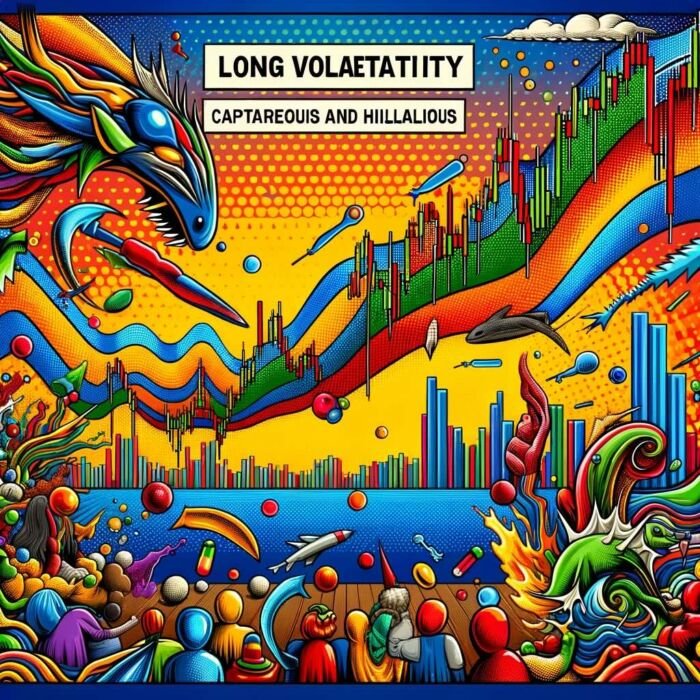
Long Volatility Strategy
Explanation of Long Volatility
Long Volatility Strategy embodies the tactical approach of capitalizing on an increase in market volatility. This strategy revolves around the expectation that market uncertainty or specific events will lead to significant price fluctuations, often in a short period. Investors who adopt this stance essentially bet on the amplification of market volatility.
Objectives of Long Volatility Strategy
The primary objective of a Long Volatility Strategy is to hedge against market downturns or to profit from periods of high market turbulence. For investors, this strategy serves as a counterbalance to traditional investments, which might suffer during times of high volatility. Essentially, it’s a form of insurance against market instability.
Types of Long Volatility Investments
Long volatility investments can take various forms, but two of the most common are Long Volatility Exchange-Traded Funds (ETFs) and Long Volatility Options.
- Long Volatility ETFs: These ETFs are designed to increase in value when market volatility rises. They track volatility indexes like the VIX (CBOE Volatility Index), providing a straightforward way for investors to gain exposure to market volatility without the complexities of options trading.
- Long Volatility Options: Options trading forms the crux of many long volatility strategies. Purchasing options, particularly puts, allows investors to profit from an increase in volatility or a decline in the underlying asset’s price. These can be more targeted than ETFs, as investors can choose specific strike prices and expiration dates that align with their market outlook.

When to Use Long Volatility
The timing and context for employing a long volatility strategy are crucial. It is typically used in the following scenarios:
- Market Conditions: During times of economic uncertainty, geopolitical tensions, or significant policy changes, markets tend to be more volatile. In these periods, a long volatility strategy can be particularly effective.
- Risk Management: For portfolio diversification, long volatility positions can hedge against downturns in other investments, especially those negatively correlated with market volatility.
Advantages and Disadvantages
A Long Volatility Strategy offers distinct advantages, such as potential high returns during turbulent market periods and effective hedging capabilities. However, it also comes with disadvantages. It can be costly, as buying options requires an upfront premium. Additionally, if the anticipated increase in volatility does not occur, the strategy can lead to significant losses, particularly as options may expire worthless.
Real-world Examples of Long Volatility Trades
Historically, long volatility strategies have shown their worth during market crashes or significant downturns. For instance, during the 2008 financial crisis or the 2020 market crash triggered by the COVID-19 pandemic, investors with long volatility positions could have realized substantial gains. These events, characterized by high uncertainty and rapid market movements, exemplify scenarios where long volatility strategies not only provided protection but also lucrative opportunities for investors who had accurately predicted the surge in market volatility.
The Long Volatility Strategy is a sophisticated approach that requires a keen understanding of market dynamics and timing. While it offers the potential for high returns during periods of increased market volatility, it also carries risks that must be carefully managed. Investors considering this strategy should be prepared for the complexity and potential costs involved, while also recognizing its power as a hedging tool in a well-diversified portfolio.
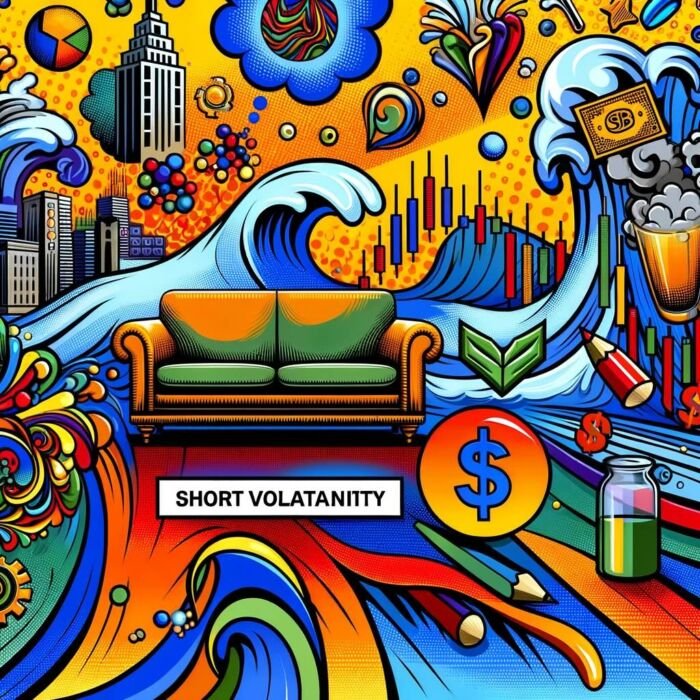
Short Volatility Strategy
Explanation of Short Volatility
The Short Volatility Strategy is an investment tactic that thrives on market stability or declining volatility. This approach involves strategies that profit from a decrease in market volatility, operating on the premise that calm or declining market conditions will persist. It’s the antithesis of the Long Volatility Strategy, flourishing in periods where market fluctuations are minimal.
Objectives of Short Volatility Strategy
The primary objective of the Short Volatility Strategy is to generate income through consistent, albeit often modest, returns. This strategy is particularly attractive in stable market environments where volatility is low or expected to decrease. Investors engage in Short Volatility as a way to capitalize on the predictability of such markets.
Types of Short Volatility Investments
Investments in a Short Volatility Strategy are typically made through Short Volatility Exchange-Traded Funds (ETFs) and Short Volatility Options.
- Short Volatility ETFs: These ETFs are designed to perform inversely to volatility indices like the VIX. They tend to increase in value when market volatility decreases, offering a straightforward method for investors to benefit from stable market conditions.
- Short Volatility Options: This involves selling options, such as writing put or call options. The idea here is to collect the premiums from the options sold. If the market remains stable or volatility declines, the options will likely expire worthless or decrease in value, allowing the investor to keep the premium as profit.

When to Use Short Volatility
Implementing a Short Volatility Strategy is most effective under specific circumstances:
- Market Conditions: It is best employed in tranquil market environments where volatility is low or expected to diminish. This strategy is prevalent during extended periods of economic growth or market stability.
- Income Generation: For investors seeking consistent income, short volatility can be an appealing strategy. It provides regular returns through the collection of premiums from sold options.
Advantages and Disadvantages
The advantages of a Short Volatility Strategy include steady income generation and performance in stable market conditions. However, the primary disadvantage lies in its risk profile. While the strategy offers consistent small returns, it exposes the investor to potentially unlimited losses in the event of a sudden spike in market volatility. This was notably evident during events like the 2018 Volatility Spike, where short volatility positions experienced significant losses.
Real-world Examples of Short Volatility Trades
One of the most notable examples of Short Volatility trades can be seen in the period following the 2008 financial crisis. During the extended bull market that followed, characterized by low volatility and steady growth, short volatility strategies proved profitable. Investors who sold options during this period generally experienced consistent returns due to the prolonged period of market stability.
The Short Volatility Strategy is a nuanced approach that requires a deep understanding of market conditions and risk management. While offering the potential for consistent income in stable market conditions, it also carries the risk of significant losses during unexpected market upheavals. Investors engaging in this strategy should have a clear understanding of market dynamics and a plan to mitigate potential risks.
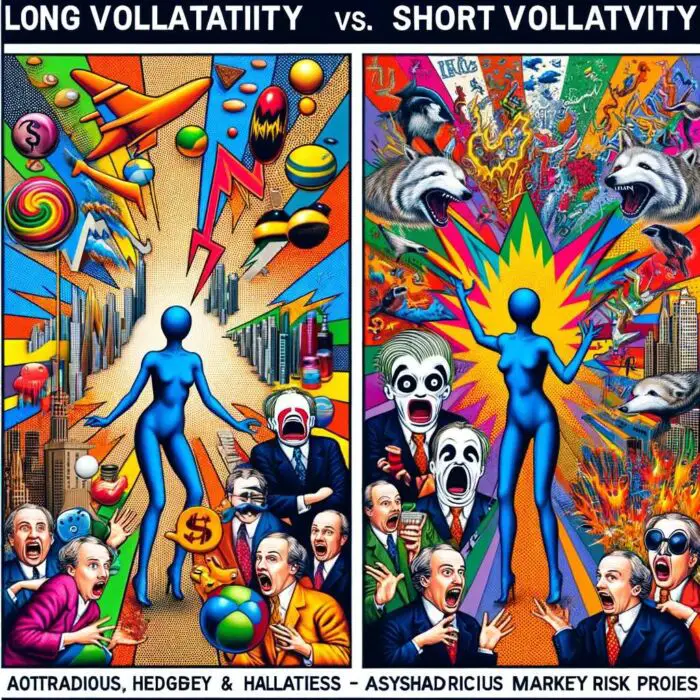
Key Differences Between Long and Short Volatility
In the intricate world of volatility trading, understanding the dichotomy between Long and Short Volatility strategies is paramount. These strategies, though rooted in the concept of market volatility, diverge significantly in their risk profiles, profit potential, suitability to market conditions, susceptibility to time decay, and their relationship with volatility indexes and benchmarks.
Risk Profiles
The risk profiles of Long and Short Volatility strategies are fundamentally distinct. A Long Volatility strategy is often seen as a form of hedging, as it typically gains value in times of market distress or high uncertainty. Its risk is somewhat predictable – the premium paid for options or the investment in long volatility ETFs. Conversely, a Short Volatility strategy entails a different kind of risk. While it can provide steady returns in a calm market, its potential for losses is asymmetrically high during unexpected spikes in volatility. This was exemplified during events like the “Volatility Spike of 2018,” where short volatility positions suffered substantial losses.
Profit Potential
The profit potential in both strategies varies considerably. Long Volatility strategies often have a lower probability of profit under normal market conditions but can yield significant returns during market turmoil. On the other hand, Short Volatility strategies typically offer more consistent, smaller gains over time but can incur severe losses during periods of market stress. This asymmetry in profit potential underscores the need for a strategic and well-considered approach in volatility trading.
Suitable Market Conditions
Long Volatility strategies flourish in turbulent market environments characterized by uncertainty, geopolitical tensions, or significant economic shifts. In contrast, Short Volatility strategies are more suited to stable, low-volatility market environments. For instance, during prolonged bull markets or periods of economic stability, short volatility positions can generate consistent returns.
Impact of Time Decay
Time decay, or theta, plays a crucial role in both strategies but affects them differently. In Long Volatility strategies, particularly those involving options, time decay works against the investor. As the expiration date of an option approaches, its time value decreases, potentially eroding profits. In Short Volatility strategies, time decay is a beneficial factor. The value of the options sold decreases over time, often leading to profits if market conditions remain stable.

Volatility Indexes and Benchmarks
Both strategies are closely tied to volatility indexes like the CBOE Volatility Index (VIX). The VIX, often termed the “fear index,” measures the market’s expectation of future volatility based on options prices of the S&P 500 index stocks. Long Volatility strategies are typically correlated with the VIX – as the VIX rises, the value of long volatility positions usually increases. Short Volatility strategies, conversely, tend to benefit when the VIX is low or declining.
In essence, the choice between Long and Short Volatility strategies depends on an investor’s risk tolerance, market outlook, and investment objectives. While Long Volatility offers a hedge against market downturns and the potential for high returns during periods of increased volatility, it carries the cost of premiums and the risk of time decay. Short Volatility, offering more consistent returns in stable conditions, poses a significant risk during market upheavals. An astute investor must navigate these nuances, aligning their strategy with their market expectations and risk appetite.

Choosing the Right Strategy
Navigating the complex terrain of volatility strategies demands a nuanced understanding of various factors. Whether to adopt a Long or Short Volatility Strategy hinges on several critical considerations. These include an investor’s risk tolerance, market outlook, investment goals, the need for portfolio diversification, and the potential of combining both strategies.
Factors to Consider
- Risk Tolerance: The foremost consideration is an investor’s risk tolerance. A Long Volatility Strategy typically involves higher risk due to the potential for loss on premiums paid for options. In contrast, a Short Volatility Strategy, while seeming less risky due to its income-generating nature, can expose investors to significant losses in times of unexpected market volatility.
- Market Outlook: The decision between long and short volatility strategies is heavily influenced by one’s market outlook. If an investor anticipates an increase in market volatility, perhaps due to economic instability or geopolitical events, a Long Volatility Strategy may be more suitable. Conversely, a Short Volatility Strategy might be preferred in a market projected to remain stable or exhibit declining volatility.
- Investment Goals: An investor’s objectives play a pivotal role. Those seeking to hedge against downturns or capitalize on market turmoil might lean towards a Long Volatility Strategy. On the other hand, those aiming for consistent income generation in stable market conditions might find a Short Volatility Strategy more appealing.
- Portfolio Diversification: Diversification is a key element in portfolio management, and volatility strategies can be instrumental in achieving it. A Long Volatility Strategy can provide a hedge against market downturns, thereby offering a form of insurance for the portfolio. A Short Volatility Strategy can complement other investments by generating income during periods of low volatility.

Combining Long and Short Volatility
An intriguing approach is the combination of Long and Short Volatility strategies. This hybrid strategy can allow investors to capitalize on market conditions as they evolve. For example, during periods of market stability, the short component can generate income, while the long component can serve as a hedge against unforeseen volatility spikes. The key to successfully implementing a combined strategy lies in the careful balance and timing of the long and short positions.
In summary, choosing between Long and Short Volatility strategies requires a comprehensive evaluation of one’s risk tolerance, market outlook, investment goals, and the need for portfolio diversification. Each strategy has its unique advantages and risks, and the choice should align with the individual investor’s overall investment strategy. Additionally, a combination of both strategies can offer a more balanced approach, potentially capitalizing on different market conditions. As with any investment strategy, careful consideration and potentially the guidance of a financial advisor are advisable to navigate these complex and often volatile waters.
Real-Life Case Studies
Exploring real-life case studies offers invaluable insights into the practical application of Long and Short Volatility strategies. These cases not only highlight the strategies’ potential but also underscore the critical lessons investors can glean from successful implementations.
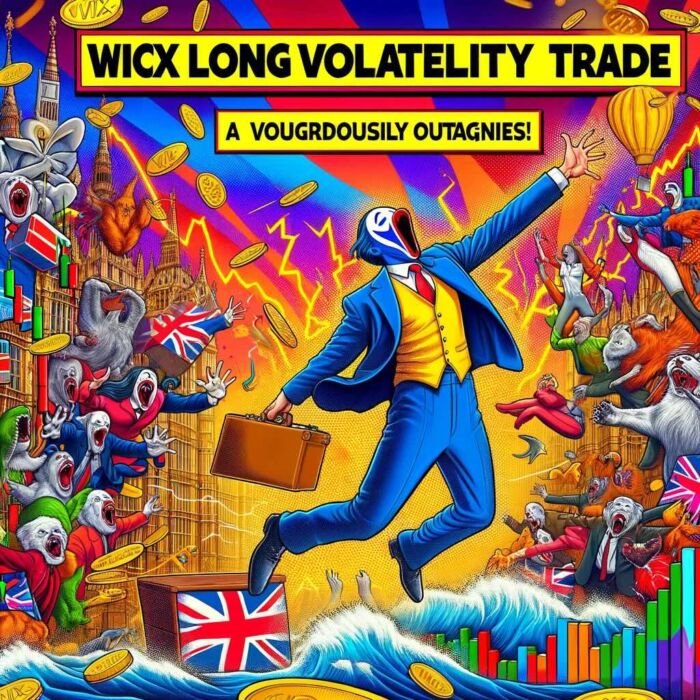
Case Study 1: Successful Long Volatility Trade
In the first case, we examine a successful Long Volatility Trade during a period of heightened market uncertainty. A pertinent example is found in the events leading up to the Brexit referendum in 2016. As political tensions and uncertainty about the outcome of the referendum escalated, a savvy investor anticipated a surge in market volatility.
This investor strategically purchased VIX call options, betting on a spike in volatility. As the referendum results came in, with the UK voting to leave the EU, global markets plunged into turmoil, and volatility spiked sharply. The VIX surged, and the value of the call options increased dramatically, resulting in substantial gains for the investor.
Key Lessons: This case underscores the importance of closely monitoring geopolitical and economic events that can trigger market volatility. It also highlights the potential of Long Volatility strategies in capitalizing on such events, provided the timing and the choice of instruments are well-calibrated.

Case Study 2: Successful Short Volatility Trade
The second case involves a successful Short Volatility Trade during a period of market stability. A classic example can be seen in the post-2008 financial crisis period, particularly between 2012 and 2017. During this time, a period of sustained economic growth and market stability prevailed.
An investor, recognizing the prolonged low-volatility environment, decided to sell VIX futures. This strategy involved taking a short position in the VIX, expecting that the low volatility would continue. As predicted, the market remained stable, and volatility stayed at historically low levels. The investor was able to profit from the gradual decline in VIX futures, capturing steady returns over this period.
Key Lessons: This case highlights the effectiveness of Short Volatility strategies in stable, low-volatility market conditions. It also emphasizes the importance of market analysis and trend recognition in executing such strategies successfully.
Lessons Learned from Both Cases
From these case studies, several key lessons emerge:
- Market Analysis and Timing: Both cases illustrate the critical importance of thorough market analysis and precise timing in executing volatility trades.
- Risk Management: While both strategies yielded significant returns, they also carried risks. Effective risk management, including setting stop-loss orders and position sizing, is crucial.
- Adaptability: The ability to adapt to changing market conditions is vital. The Long Volatility strategy was effective in a high-uncertainty scenario, while the Short Volatility strategy worked well in a stable environment.
- Diversification: These strategies should ideally be part of a diversified portfolio to mitigate overall investment risk.
These real-life case studies of Long and Short Volatility trades offer powerful lessons in strategic planning, market analysis, risk management, and adaptability. They serve as compelling examples for investors seeking to navigate the complex yet potentially rewarding world of volatility trading.
Risks and Pitfalls
The intricate dance of volatility trading, with its high stakes and potential for significant returns, also brings with it a spectrum of risks and pitfalls. Investors navigating the Long and Short Volatility terrains must be acutely aware of the common missteps and employ robust risk management strategies to mitigate potential losses.

Common Mistakes to Avoid with Long Volatility
- Misjudging Market Conditions: One of the most prevalent errors in a Long Volatility strategy is misinterpreting market signals, leading to ill-timed trades. Investors often misjudge the onset of market volatility, entering positions too early or too late.
- Overexposure: Given the high-risk nature of Long Volatility trades, overexposing one’s portfolio can lead to significant losses, especially if the anticipated volatility spike does not materialize.
- Neglecting Time Decay: In options-based Long Volatility strategies, time decay can erode the value of options, particularly if the expected increase in volatility is delayed. Investors often underestimate this effect, resulting in diminishing returns.
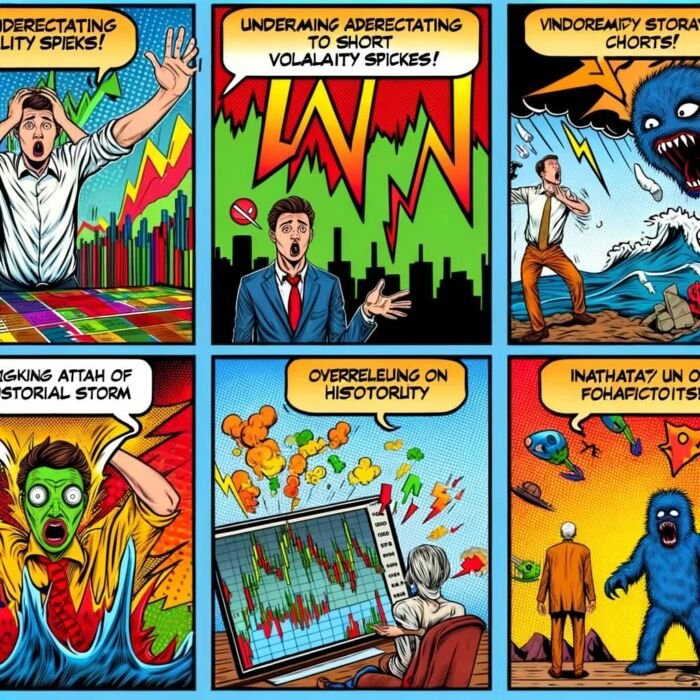
Common Mistakes to Avoid with Short Volatility
- Underestimating Volatility Spikes: A critical mistake in Short Volatility strategies is underestimating the potential for sudden volatility spikes. This can lead to substantial losses, as seen in historical market events where volatility surged unexpectedly.
- Overreliance on Historical Trends: While historical data is valuable, overreliance on past trends without considering current market dynamics can be misleading. Markets are dynamic, and conditions change, sometimes rendering historical patterns obsolete.
- Inadequate Hedging: Failing to adequately hedge short volatility positions can leave an investor exposed to extreme market movements. Effective hedging is crucial to protect against unforeseen market shifts.
Risk Management Strategies
To navigate these risks, investors should employ robust risk management strategies:
- Diversification: Diversification is a cornerstone of risk mitigation. Balancing Long and Short Volatility positions with other asset classes can help cushion the impact of adverse market movements.
- Position Sizing: Proper position sizing is essential. Limiting the size of volatility trades relative to the overall portfolio can reduce the risk of significant losses.
- Stop-Loss Orders: Implementing stop-loss orders can prevent large-scale losses. This involves setting predetermined levels at which a position is automatically closed to limit potential losses.
- Regular Monitoring and Adjustment: Volatility markets require constant vigilance. Regularly monitoring and being prepared to adjust positions in response to market changes can help manage risks effectively.
- Utilizing Options Strategically: When dealing with options, using strategies like spreads can limit potential losses compared to naked positions.
- Seeking Expert Advice: Especially for less experienced investors, consulting with financial advisors or volatility trading experts can provide valuable insights and guidance.
While Long and Short Volatility strategies offer potential for substantial returns, they come with significant risks. Avoiding common mistakes and adhering to disciplined risk management practices are vital for navigating these complex and often turbulent trading waters. An informed, measured approach can help mitigate risks and capitalize on the opportunities presented by market volatility.
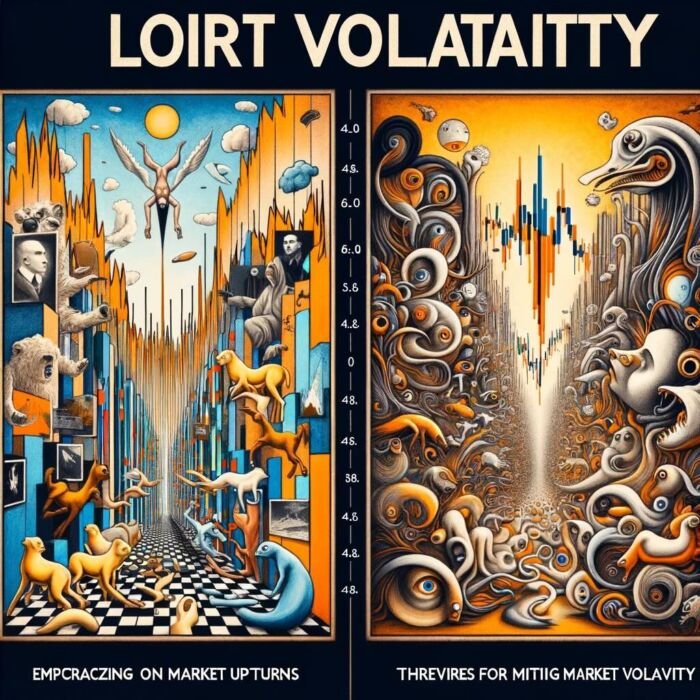
Recap of Long and Short Volatility
In this exploration of Long and Short Volatility strategies, we have navigated through the complex and dynamic world of market volatility. Understanding these strategies is imperative for investors seeking to tailor their portfolios to capitalize on or protect against market fluctuations.
A Long Volatility Strategy is predicated on benefiting from increases in market volatility. It is typically adopted in anticipation of market uncertainty or significant events that could trigger market upheaval. This strategy, often implemented through purchasing options or investing in volatility ETFs, can serve as a hedge against downturns in traditional investments.
Conversely, a Short Volatility Strategy thrives in environments of declining or stable market volatility. It involves strategies such as selling options or investing in inverse volatility ETFs, aiming to generate consistent returns in tranquil market conditions. However, this strategy carries the risk of substantial losses in the event of unexpected market volatility spikes.
How to Implement These Strategies Effectively
- Understanding Market Dynamics: A deep understanding of market conditions and economic indicators is crucial. This knowledge aids in predicting shifts in volatility that can impact these strategies.
- Risk Assessment: Assessing and managing risk is vital. This involves considering factors like market exposure, position sizing, and the potential impact of economic events.
- Portfolio Diversification: Integrating Long or Short Volatility strategies into a diversified portfolio can provide balance. It allows investors to mitigate risks while positioning for potential gains.
- Timely Execution: The effectiveness of these strategies often hinges on timing. Recognizing the right moment to enter or exit a position is key to maximizing returns or minimizing losses.
- Continuous Learning and Adaptation: The volatility market is continuously evolving. Staying informed and being adaptable to new information and market changes is essential.

Final Thoughts on Long vs. Short Volatility
Choosing between Long and Short Volatility strategies is not a matter of which is inherently better, but which is more aligned with an investor’s risk tolerance, market outlook, and investment goals. Each strategy has its unique set of risks and rewards.
Long Volatility strategies are suitable for those who seek to hedge against or profit from market uncertainties and sharp fluctuations. They require a readiness to face the potential loss of premiums paid and the challenges posed by time decay in options.
Short Volatility strategies, on the other hand, are fitting for investors who prefer steady income in periods of market stability but come with the caveat of potentially unlimited losses during volatility spikes.
In conclusion, both Long and Short Volatility strategies offer valuable tools for investors. The key lies in understanding their intricacies, aligning them with one’s investment philosophy, and executing them with prudence and strategic foresight. As with any investment strategy, there is no one-size-fits-all approach. Each investor must weigh the pros and cons, consider their unique circumstances, and perhaps seek expert advice to navigate the volatile yet potentially rewarding realm of volatility trading.
Important Information
Investment Disclaimer: The content provided here is for informational purposes only and does not constitute financial, investment, tax or professional advice. Investments carry risks and are not guaranteed; errors in data may occur. Past performance, including backtest results, does not guarantee future outcomes. Please note that indexes are benchmarks and not directly investable. All examples are purely hypothetical. Do your own due diligence. You should conduct your own research and consult a professional advisor before making investment decisions.
“Picture Perfect Portfolios” does not endorse or guarantee the accuracy of the information in this post and is not responsible for any financial losses or damages incurred from relying on this information. Investing involves the risk of loss and is not suitable for all investors. When it comes to capital efficiency, using leverage (or leveraged products) in investing amplifies both potential gains and losses, making it possible to lose more than your initial investment. It involves higher risk and costs, including possible margin calls and interest expenses, which can adversely affect your financial condition. The views and opinions expressed in this post are solely those of the author and do not necessarily reflect the official policy or position of anyone else. You can read my complete disclaimer here.






